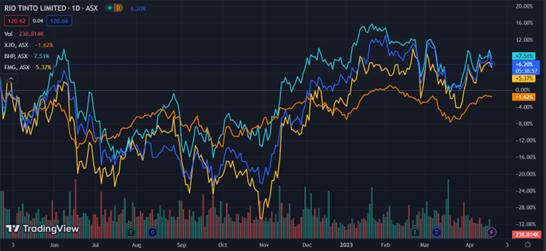Diversified mining behemoth Rio Tinto [ASX:RIO] has revealed a new record for exports in its Australian iron ore segment, which surged 16% in for the first three months of the year.
Pilbara iron ore shipped 82.54 million tonnes, suggesting a promising era for the miner’s flagship business.
While focus was on its new record this morning, a downgrade to copper production guidance was also flagged on complications at mines in the US and Chile.
RIO was trading for $123.19 a share at the time of writing, after a subtle uplift to share price.
It has risen nearly 6% year-to-date, and also continues leading in its sector average by nearly 6% along with peers BHP and Fortescue:

Source: TradingView
Rio Tinto’s new first quarter production record
Today, the iron giant celebrated its best historical start to the year touting an uplift of 16% in Australian iron ore export volumes.
Its Pilbara operations produced 79.3 million tonnes (100% basis) in the first quarter, 11% higher than the first quarter of 2022.
This led to shipments of 82.5 million tonnes, a 16% increase in export over the same time last year, breaking its first quarter record today.
This number surpasses the group’s previous record of 2018, when RIO managed to ship 80.31 million tonnes.
Rio said the increase was delivered through stronger mine production and a drawdown of stocks.
As for its other minerals, RIO said bauxite production hit 12.1 million tonnes, 11% lower than the first quarter of 2022 due to higher-than-average rainfall at its Weipa operations, yet aluminium production of 0.8 million tonnes was 7% higher than the same time last year thanks to benefits from the continued ramp-up of the Kitimat smelter.
Rio said recovery at the Boyne and Kitimat smelters is progressing to plan with full ramp-up expected to end later in the year.
Mined copper production of 145,000 tonnes were in line with the first quarter of 2022 while titanium dioxide slag production was 4% higher than the first quarter of 2022 and IOC production rose 5%.
Rio adjusts guidance
The surge in export volumes adding to signs Rio’s flagship business has turned a corner.
However, some results were offset by a copper production guidance downgrade, which the group explained was due to some technical difficulties at its copper mines in Chile and the US.
Production was also affected by equipment downtime at Weipa and Gove, and yet the group maintains bauxite production guidance at 54–57 million tonnes as it works to recover lost production at both sites this year.
Mined copper guidance for 2023 has been lowered to 590–640 thousand tonnes (previously 650–710 thousand tonnes) on a conveyor outage at Kennecott, and geotechnical challenges in the open pit at Escondida.
Rio believes it can ship 320–335 million tonnes from its WA operations this year.
So far, its export rate over the past three months suggests that Rio could be shipping 334.7 million tonnes provided its performance remains just as strong for the rest of 2023.
Rio also said that its initial estimates for a starter plant at Rincon — which would cost US$140 million — are under review, with the group having taken some hefty impacts off the back of cost inflation.
A boom for drillers
Drillers are booming.
More booms are marked to happen for every single metal on the periodic table.
Aussie mining is at its best right now, but if so many of them topped 2022, can they really do it again in 2023?
Our experts definitely seem to think so. But how do you tell which ones?
You may need a little help from our commodities expert James Cooper.
James has spent time out in the field and brings the inside-industry knowledge to you, here at Fat Tail Investment Research.
Let’s start with six ASX mining stocks that are heading to top the charts.
Regards,
Mahlia Stewart,
For The Daily Reckoning Australia

